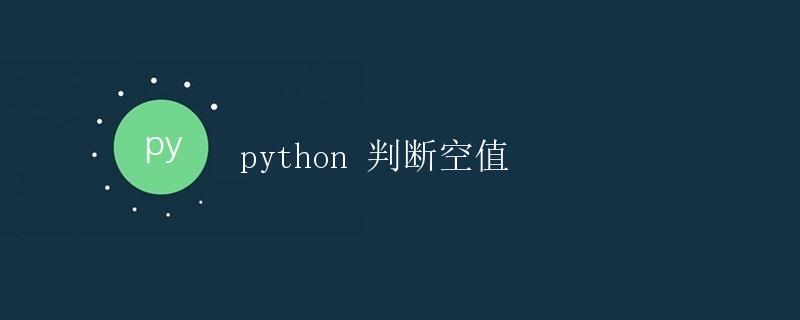Python 判断空值

在Python中,经常会遇到需要判断一个值是否为空的情况。判断一个值是否为空对于程序的正确性和稳定性非常重要。在Python中,常见的空值有None、空字符串”、空列表[]、空元组()和空字典{}等。本文将详细介绍如何使用Python来判断空值,并给出相应的示例代码和运行结果。
判断None值
在Python中,None表示空值或者空对象。可以使用is关键字来判断一个值是否为None。下面是使用is关键字来判断一个值是否为None的示例代码:
a = None
if a is None:
print("a is None")
else:
print("a is not None")
运行结果:
a is None
判断空字符串
空字符串''表示没有任何字符的字符串。可以使用==关键字来判断一个字符串是否为空。下面是使用==关键字来判断一个字符串是否为空的示例代码:
s = ''
if s == '':
print("s is an empty string")
else:
print("s is not an empty string")
运行结果:
s is an empty string
判断空列表
空列表[]表示没有任何元素的列表。可以使用==关键字来判断一个列表是否为空。下面是使用==关键字来判断一个列表是否为空的示例代码:
lst = []
if lst == []:
print("lst is an empty list")
else:
print("lst is not an empty list")
运行结果:
lst is an empty list
判断空元组
空元组()表示没有任何元素的元组。可以使用==关键字来判断一个元组是否为空。下面是使用==关键字来判断一个元组是否为空的示例代码:
t = ()
if t == ():
print("t is an empty tuple")
else:
print("t is not an empty tuple")
运行结果:
t is an empty tuple
判断空字典
空字典{}表示没有任何键值对的字典。可以使用==关键字来判断一个字典是否为空。下面是使用==关键字来判断一个字典是否为空的示例代码:
d = {}
if d == {}:
print("d is an empty dictionary")
else:
print("d is not an empty dictionary")
运行结果:
d is an empty dictionary
综合判断方法
除了使用is和==关键字来判断空值外,还可以利用Python中的bool()函数来判断一个值是否为空。bool()函数会将一个值转换为布尔型,空值会被转换为False,非空值会被转换为True。下面是使用bool()函数来判断空值的示例代码:
# 判断None值
a = None
if not bool(a):
print("a is None")
# 判断空字符串
s = ''
if not bool(s):
print("s is an empty string")
# 判断空列表
lst = []
if not bool(lst):
print("lst is an empty list")
# 判断空元组
t = ()
if not bool(t):
print("t is an empty tuple")
# 判断空字典
d = {}
if not bool(d):
print("d is an empty dictionary")
运行结果:
a is None
s is an empty string
lst is an empty list
t is an empty tuple
d is an empty dictionary
总结
本文介绍了在Python中如何判断空值,包括None值、空字符串、空列表、空元组和空字典等。通过使用is和==关键字,以及bool()函数,可以轻松地判断一个值是否为空,从而确保程序的正确性和稳定性。
 极客教程
极客教程